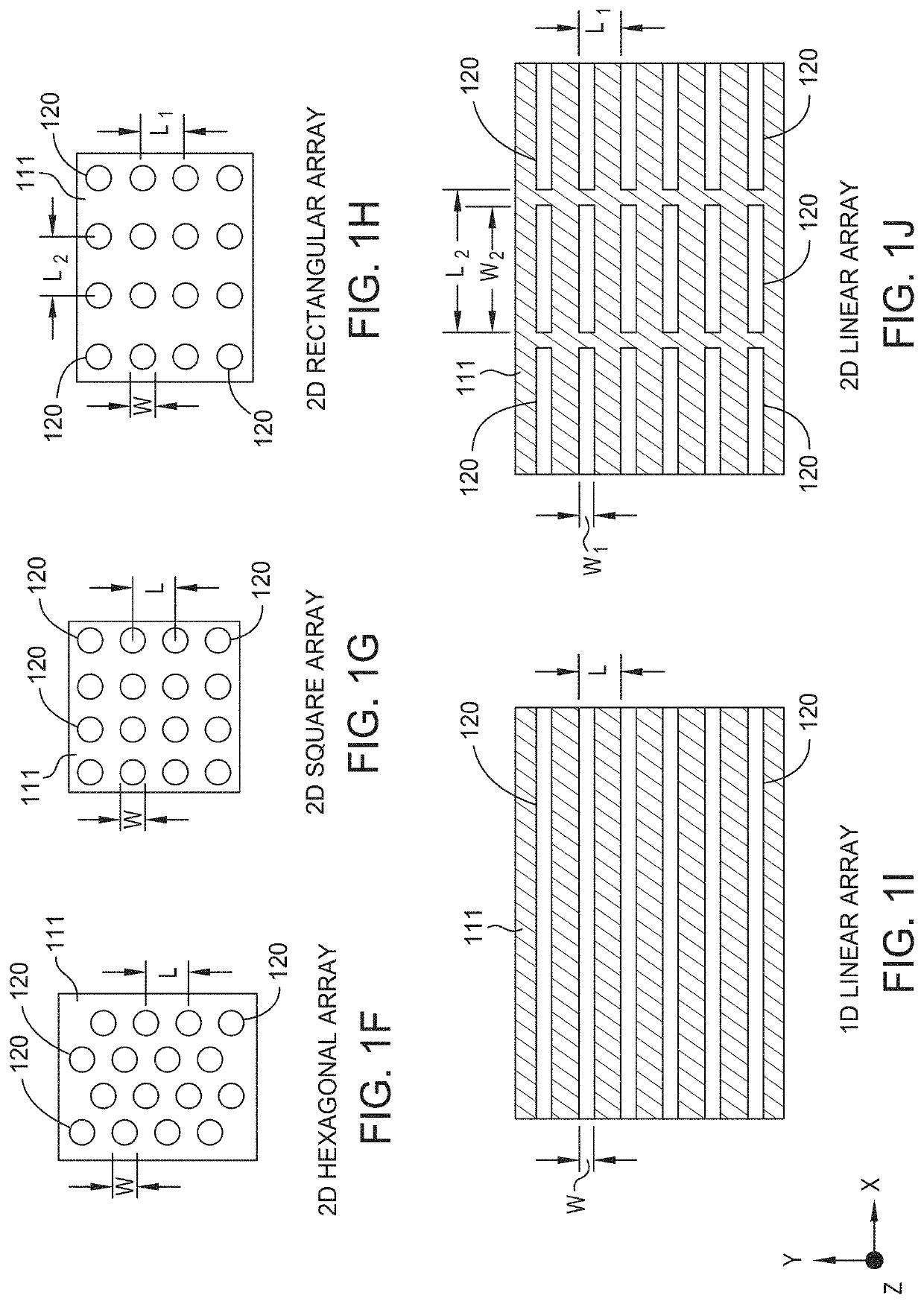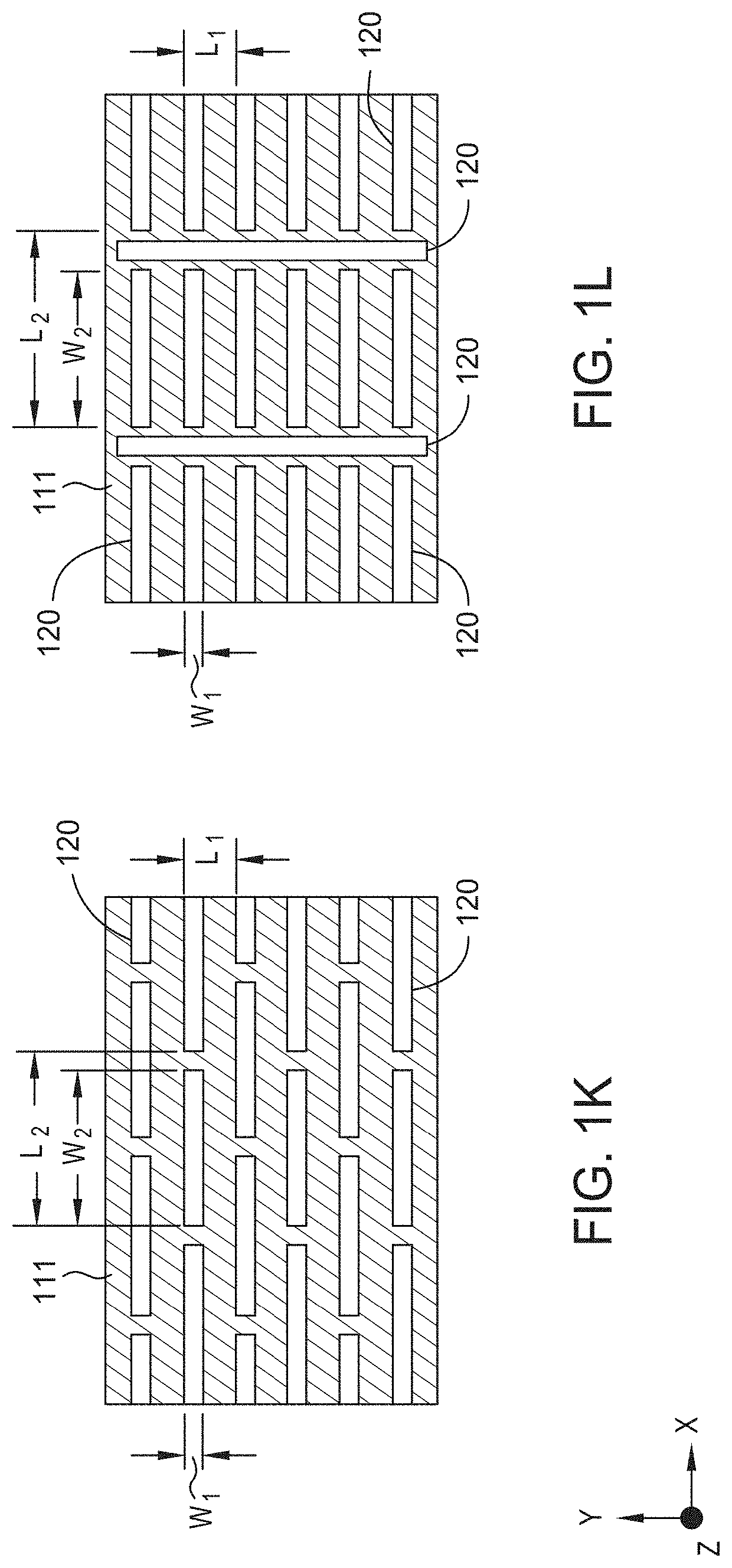Improved group iii nitride substrate, method of making, and method of use
a technology of nitride substrate and nitride, which is applied in the direction of polycrystalline material growth, crystal growth process, after-treatment details, etc., can solve the problems of thermal expansion mismatch, impurities, tilt boundaries, and additional defects that can arise from thermal expansion mismatch, etc., to achieve the effect of reducing the number of defects, and reducing the quality of the devi
- Summary
- Abstract
- Description
- Claims
- Application Information
AI Technical Summary
Benefits of technology
Problems solved by technology
Method used
Image
Examples
example 1
[0089]A c-plane oriented bulk GaN crystal grown by HVPE, approximately 0.3 millimeters thick, was provided for use as a substrate 101 for patterning and ammonothermal crystal growth. A 100-nanometer-thick layer of TiW was sputter-deposited as an adhesion layer on the (000-1) N-face of the substrate, followed by a 780-nanometer-thick inert layer comprising Au. A 6-micrometer-thick Au layer was then electroplated on the sputtered layer, increasing the thickness of the inert layer (e.g., blanket mask 116). Using AZ-4300 as a photoresist (e.g., photoresist layer 103), a pattern comprising linear arrays of 3-micrometer-wide by 1-centimeter-long slits (e.g., openings 112), with a pitch diameter of 1200 micrometers was defined. A wet-etch process was performed, using a commercial TFA gold etching solution at room temperature, as shown schematically in FIGS. 1M-1P, to obtain a substrate with patterned mask layer 111. The mask pattern comprised domains of m-stripes, with linear openings orie...
example 2
[0090]A patterned, trenched c-plane-oriented bulk GaN substrate 101 was prepared by a similar procedure as that described in Example 1. The patterned substrate was placed in a silver capsule along with a 15%-open-area baffle, polycrystalline GaN nutrient, NH4F mineralizer, and ammonia, and the capsule was sealed. The ratios of GaN nutrient and NH4F mineralizer to ammonia were approximately 1.69 and 0.099 respectively, by weight. The capsule was placed in an internally-heated high pressure apparatus and heated to temperatures of approximately 666 degrees Celsius for the upper, nutrient zone and approximately 681 degrees Celsius for the lower, crystal growth zone, maintained at these temperatures for approximately 215 hours, and then cooled and removed. Ammonothermal GaN filled in most of the volume in the trenches, grew through the linear openings in the patterned mask on the HVPE GaN substrate, grew laterally, and coalesced fully, forming an ammonothermal GaN layer approximately 120...
example 3
[0091]A patterned, trenched c-plane-oriented bulk GaN substrate was prepared by a similar procedure as that described in Examples 1 and 2, and the final group III metal nitride layer 213 is shown in FIG. 12B (i.e., right side figures). A second patterned substrate was prepared by a similar procedure except that no trenches were prepared below the mask openings, and the final group III metal nitride layer is shown in FIG. 12A (i.e., left side figures). The patterned substrates were placed in a silver capsule along with a 15%-open-area baffle, polycrystalline GaN nutrient, NH4F mineralizer, and ammonia, and the capsule was sealed. The ratios of GaN nutrient and NH4F mineralizer to ammonia were approximately 2.05 and 0.099 respectively, by weight. The capsule was placed in an internally-heated high pressure apparatus and heated to temperatures of approximately 666 degrees Celsius for the upper, nutrient zone and approximately 678 degrees Celsius for the lower, crystal growth zone, main...
PUM
| Property | Measurement | Unit |
|---|---|---|
| miscut angle | aaaaa | aaaaa |
| height | aaaaa | aaaaa |
| thickness | aaaaa | aaaaa |
Abstract
Description
Claims
Application Information
 Login to View More
Login to View More - R&D
- Intellectual Property
- Life Sciences
- Materials
- Tech Scout
- Unparalleled Data Quality
- Higher Quality Content
- 60% Fewer Hallucinations
Browse by: Latest US Patents, China's latest patents, Technical Efficacy Thesaurus, Application Domain, Technology Topic, Popular Technical Reports.
© 2025 PatSnap. All rights reserved.Legal|Privacy policy|Modern Slavery Act Transparency Statement|Sitemap|About US| Contact US: help@patsnap.com



